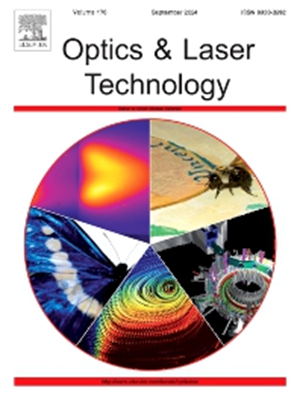Thermal deformation detection and analysis of C/C composites during laser processing
IF 4.6
2区 物理与天体物理
Q1 OPTICS
引用次数: 0
Abstract
In this study, aiming to address the deformation issue caused by thermal stress concentration, the digital image correlation (DIC) technique was employed to analyze the effects of processing parameters on strain during nanosecond-pulsed laser processing of carbon fiber-reinforced carbon matrix (C/C) composites. Results of the study indicated that the deformations increase in all directions as time proceeds. The strain perpendicular to the scanning direction was significantly higher than the parallel to the scanning direction and the combined strain in both directions. Furthermore, the maximum deformation was concentrated at the cut edges. A higher repetition frequency was found to cause smaller longitudinal strains in the material. When the laser power was low, the material had a larger negative strain, whereas increasing the power gradually increased the strains to positive values. Additionally, lower scanning speeds resulted in larger deformations, while the effect of pulse width on deformation was nonlinear. The optimal process parameters were determined by combining the orthogonal test with strain analysis results. The effectiveness of the optimized parameters was finally confirmed through analysis of the test data.

求助全文
约1分钟内获得全文
求助全文
来源期刊
CiteScore
8.50
自引率
10.00%
发文量
1060
审稿时长
3.4 months
期刊介绍:
Optics & Laser Technology aims to provide a vehicle for the publication of a broad range of high quality research and review papers in those fields of scientific and engineering research appertaining to the development and application of the technology of optics and lasers. Papers describing original work in these areas are submitted to rigorous refereeing prior to acceptance for publication.
The scope of Optics & Laser Technology encompasses, but is not restricted to, the following areas:
•development in all types of lasers
•developments in optoelectronic devices and photonics
•developments in new photonics and optical concepts
•developments in conventional optics, optical instruments and components
•techniques of optical metrology, including interferometry and optical fibre sensors
•LIDAR and other non-contact optical measurement techniques, including optical methods in heat and fluid flow
•applications of lasers to materials processing, optical NDT display (including holography) and optical communication
•research and development in the field of laser safety including studies of hazards resulting from the applications of lasers (laser safety, hazards of laser fume)
•developments in optical computing and optical information processing
•developments in new optical materials
•developments in new optical characterization methods and techniques
•developments in quantum optics
•developments in light assisted micro and nanofabrication methods and techniques
•developments in nanophotonics and biophotonics
•developments in imaging processing and systems

 求助内容:
求助内容: 应助结果提醒方式:
应助结果提醒方式:


